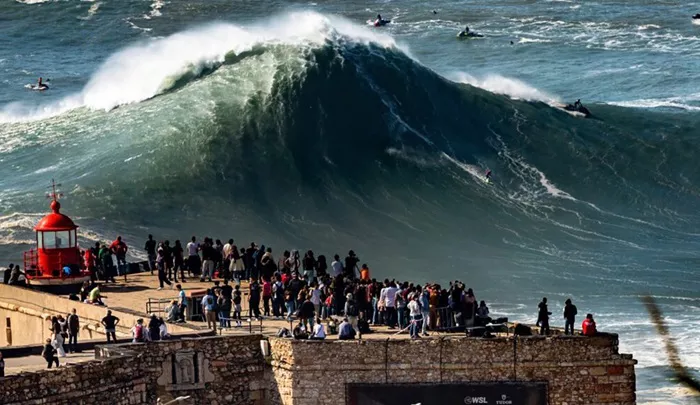Surfing is an exhilarating sport that attracts wave riders from around the world, seeking the ultimate challenge. While there are countless surf spots globally, only a few locations boast truly massive waves capable of testing the limits of even the most skilled surfers. These colossal waves are created by a combination of ocean swells, underwater topography, and wind patterns, forming some of the most dangerous yet awe-inspiring waves on the planet.
For big-wave surfers, finding the perfect wave is a lifelong pursuit, requiring skill, experience, and sometimes sheer bravery. Some of these waves reach heights of over 80 feet, with forces strong enough to challenge human endurance. From the legendary breaks of Hawaii to the monstrous swells of Portugal, this article explores the biggest surfing waves in the world and what makes them so special.
1. Nazaré, Portugal: Home of Record-Breaking Waves
Nazaré has become synonymous with giant waves, often breaking records for the tallest waves ever surfed. This Portuguese fishing village gained global attention when Garrett McNamara rode a 78-foot wave in 2011, setting a world record at the time. Since then, the waves at Praia do Norte have continued to amaze the surfing community, with even larger waves being surfed in subsequent years.
Why Are Nazaré Waves So Big?
Underwater Canyon: The Nazaré Canyon, a deep underwater trench, channels and amplifies incoming ocean swells, producing some of the world’s biggest waves.
Perfect Swell Conditions: The North Atlantic storms generate massive swells that travel toward Nazaré, creating record-breaking waves.
Winter Surfing Season: The biggest waves occur between October and March, attracting elite surfers willing to take on this formidable challenge.
2. Jaws (Peahi), Hawaii: The Ultimate Big-Wave Arena
Peahi, commonly known as Jaws, is one of the most iconic big-wave surf spots in the world. Located on the north shore of Maui, Jaws is known for its ferocious power, consistency, and perfect barrels.
What Makes Jaws Unique?
Unparalleled Power: Waves at Jaws can reach 60 feet and break with incredible force, making wipeouts extremely dangerous.
Tow-In Surfing Origin: Due to the sheer size and speed of the waves, surfers often use jet skis to tow themselves into position.
Biggest Swells in Winter: The biggest and best conditions occur between November and March when massive North Pacific swells arrive.
3. Mavericks, California: A Cold-Water Beast
Located off the coast of Half Moon Bay, California, Mavericks is one of the most dangerous and revered big-wave surf spots in the world. The wave forms over an unforgiving reef, producing some of the heaviest and most powerful waves on the planet.
Why Is Mavericks So Notorious?
Huge Swells: Waves can reach 50-60 feet, with walls of water that can hold surfers down for minutes.
Freezing Temperatures: The cold Pacific Ocean and strong currents add to the challenge of surfing Mavericks.
Deadly Reputation: Mavericks has claimed the lives of several experienced surfers, making it one of the most respected waves in the world.
4. Teahupo’o, Tahiti: The Heaviest Wave on Earth
Teahupo’o (pronounced “Cho-po”) is famous for its incredibly thick and hollow waves, making it one of the heaviest waves on the planet. Unlike other big-wave spots, Teahupo’o doesn’t just rise high—it is known for its extreme force and steep drops.
What Sets Teahupo’o Apart?
Massive Barrels: The wave is known for its thick lips, creating some of the most beautiful and terrifying barrels in surfing.
Shallow Reef: The razor-sharp coral reef sits just below the surface, making wipeouts highly dangerous.
Year-Round Swells: While it breaks consistently, the biggest swells typically hit between May and October.
5. Cortes Bank, California: An Open-Ocean Giant
Cortes Bank is a unique big-wave surf spot located 100 miles off the California coast in the middle of the Pacific Ocean. This submerged seamount creates waves that rise abruptly in deep water, making it one of the most remote and dangerous surf locations in the world.
Why Is Cortes Bank So Challenging?
Massive Open-Ocean Waves: Swells can reach 80 feet or more, with no land in sight.
Unpredictable Conditions: The waves break unpredictably due to deep water and strong ocean currents.
Extreme Risk: The remote location makes rescues extremely difficult in case of emergencies.
6. Shipstern Bluff, Australia: The Mutant Wave
Located off the coast of Tasmania, Shipstern Bluff is famous for its unpredictable, step-like waves that make it one of the most unique and dangerous big-wave spots.
Key Characteristics of Shipstern Bluff
Unusual Wave Formation: The wave often forms multiple steps, making takeoffs extremely tricky.
Remote and Isolated: Surfers must take a long boat ride or hike through rugged terrain to reach the break.
Huge Swells: The biggest waves occur during strong Southern Ocean swells, typically between May and September.
Conclusion
For big-wave surfers, these locations represent the ultimate proving grounds, pushing the limits of what is possible in the sport of surfing. Whether it’s the monstrous swells of Nazaré, the perfect barrels of Teahupo’o, or the open-ocean behemoth of Cortes Bank, these waves demand skill, experience, and an unbreakable spirit.
Each wave spot has unique characteristics that make it special, from underwater topography to swell direction. But one thing they all have in common is their ability to inspire awe and challenge the bravest surfers. Whether you’re an aspiring big-wave rider or an admirer of the sport, these legendary surf breaks represent the pinnacle of extreme surfing.

